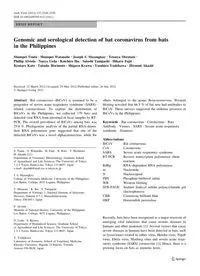
2012 Genomic and serological detection of bat coronavirus from bats in the Philippines PDF
Preview 2012 Genomic and serological detection of bat coronavirus from bats in the Philippines
BRIEF REPORT Genomic and serological detection of bat coronavirus from bats in the Philippines Shumpei Tsuda • Shumpei Watanabe • Joseph S. Masangkay • Tetsuya Mizutani • Phillip Alviola • Naoya Ueda • Koichiro Iha • Satoshi Taniguchi • Hikaru Fujii • Kentaro Kato • Taisuke Horimoto • Shigeru Kyuwa • Yasuhiro Yoshikawa • Hiroomi Akashi Received: 12 March 2012 / Accepted: 29 May 2012 / Published online: 26 July 2012 � Springer-Verlag 2012 Abstract Bat coronavirus (BtCoV) is assumed to be a progenitor of severe acute respiratory syndrome (SARS)- related coronaviruses. To explore the distribution of BtCoVs in the Philippines, we collected 179 bats and detected viral RNA from intestinal or fecal samples by RT- PCR. The overall prevalence of BtCoVs among bats was 29.6 %. Phylogenetic analysis of the partial RNA-depen- dent RNA polymerase gene suggested that one of the detected BtCoVs was a novel alphacoronavirus, while the others belonged to the genus Betacoronavirus. Western blotting revealed that 66.5 % of bat sera had antibodies to BtCoV. These surveys suggested the endemic presence of BtCoVs in the Philippines. Keywords Bat coronavirus � Coronavirus � Bats � Antibody � Viruses � SARS � Severe acute respiratory syndrome � Zoonosis Abbreviations BtCoV Bat coronavirus CoV Coronavirus SARS Severe acute respiratory syndrome RT-PCR Reverse transcriptase polymerase chain reaction RdRp RNA–dependent RNA polymerase nt Nucleotide N Nucleocapsid PBS Phosphate-buffered saline WB Western blotting SDS-PAGE Sodium dodecyl sulfate polyacrylamide gel electrophoresis CBB Coomassie brilliant blue HRP Horseradish peroxidase Recently, bats have been recognized as a major reservoir of emerging viral infections that cause serious diseases in humans and other mammals [1]. Several viruses that cause severe diseases in humans have been detected in bats, such as lyssaviruses related to rabies virus, Hendra virus, Nipah virus, Ebola virus, Marburg virus and severe acute respi- ratory syndrome (SARS) coronavirus [1]. Hence, there is a growing focus on bats as zoonotic hosts. S. Tsuda � S. Watanabe � H. Fujii � K. Kato � T. Horimoto � H. Akashi (&) Department of Veterinary Microbiology, Graduate School of Agricultural and Life Sciences, The University of Tokyo, 1-1-1 Yayoi, Bunkyo-ku, Tokyo 113-8657, Japan e-mail:
